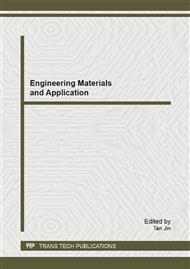[1]
D.L. Donoho, De-noising by soft thresholding, IEEE Transactions on Information Theory. 41 (1995) 613-627.
DOI: 10.1109/18.382009
Google Scholar
[2]
D.L. Donoho, I.M. Johnstone, Ideal spatial adaptation via wavelet shrinkage, Biometrica. 81 (1994) 425-455.
DOI: 10.1093/biomet/81.3.425
Google Scholar
[3]
C.K. Chui, An Introduction to Wavelets, Academic Press, Boston, USA, (1992).
Google Scholar
[4]
E. -S.A. El-Dahshan, Genetic algorithm and wavelet hybrid scheme for ECG signal denoising, Telecommun Syst. 46 (2011) 209-215.
DOI: 10.1007/s11235-010-9286-2
Google Scholar
[5]
T. Cai, J. Zhu, Wavelet de-noising of speech using singular spectrum analysis for decomposition level selection, Journal o f Shanghai Jiao tong University (Science). E-12 (2007) 190-196.
Google Scholar
[6]
Y.F. Sang, D. Wang, J.C. Wu, Entropy-based method of choosing the decomposition level in wavelet threshold de-noising, Entropy. 6 (2010) 1499-1513.
DOI: 10.3390/e12061499
Google Scholar
[7]
E.T. Jaynes, Information theory and statistical mechanics, Physical Review. 106 (1957) 620–630.
Google Scholar
[8]
Y.F. Sang, D. Wang, J.C. Wu, Uncertainty analysis of decomposition level choice in wavelet threshold de-noising, Entropy. 12 (2010) 2386-2396.
DOI: 10.3390/e12122386
Google Scholar
[9]
J. Huang, J. Xie, H. Li, G. Tian, X. Chen, Self-adaptive decomposition level de-noising method based on wavelet transform, Indonesian Journal of Electrical Engineering. 10 (2012) 1015-1020.
DOI: 10.11591/telkomnika.v10i5.1366
Google Scholar
[10]
T.Y. Sun, C.C. Liu, S.T. Hsieh, T.Y. Tsai, J.H. Jheng, Optimal determination of wavelet threshold and decomposition level via heuristic learning for noise reduction, IEEE Conference on Soft Computing in Industrial Applications, 2008, 405-410.
DOI: 10.1109/smcia.2008.5045998
Google Scholar
[11]
S. Mallat, A Wavelet Tour of Signal Processing: the sparse way, 3rd edition, Academic Press, Orlando, (2009).
Google Scholar
[12]
D.B. Percival, A.T. Walden, Wavelet Methods for Time Series Analysis, Cambridge University Press, Cambridge, UK, (2000).
Google Scholar
[13]
R. Remesan, M. A. Shamim, D. Han, Model data selection using gamma test for daily solar radiation estimation, Hydrol. Process. 22 (2008) 4301-4309.
DOI: 10.1002/hyp.7044
Google Scholar
[14]
A.J. Jones , S.E. Kemp, Heuristic confidence intervals for the Gamma test, The 2006 International Conference on Artificial Intelligence, 2006, 522-526.
Google Scholar
[15]
W.Z.W. Jaafar, D. Han, Variable selection using the Gamma test forward and backward selections, Journal of Hydrologic Engineering, 17 (2012) 182-190.
DOI: 10.1061/(asce)he.1943-5584.0000403
Google Scholar


